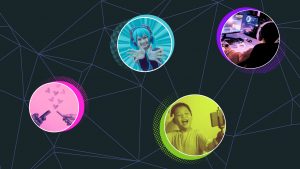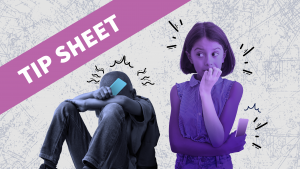
Social contagion – the rapid spread of behavior, attitudes, or emotions through a social group – has been documented for centuries. The recent development of online content delivered by powerful algorithms on platforms popular with youth has increased the speed and reach of socially contagious behaviors – as well as its possible harms. How is online content impacting children and adolescents via acquisition of movement disorder symptoms, self-harm, and suicide? What can be done to help prevent harmful social contagion online for youth?
On This Page
About Social Contagion
What is Social Contagion?
Social contagion is how exposure to a behavior by one or more people influences others to engage in the same or similar behavior, says Vicki Harrison, MSW, Program Director, Center for Youth Mental Health and Wellbeing, Department of Psychiatry and Behavioral Sciences, Stanford University School of Medicine. Just as biological pathogens spread through exposure, emotions and behavior can also spread in the same type of way, she says.
Examples of social contagion that spread through digital media include non-suicidal self-injury and suicide, viral challenges, and the self-diagnosis and adoption of symptoms of specific medical or mental disorders.
Adolescents are More Susceptible to Social Contagion
Typical characteristics of adolescent brain development such as sensitivity to peer influence, proneness to impulsivity and risk-taking, and heightened need for a sense of belonging make adolescents particularly susceptible to social contagion behavior, says Harrison. “The adolescent stage is different from being a fully formed adult.” Adding these tendencies to the amplification of messages that is made possible by the saturation of digital media into modern adolescents’ lives can have a real impact, she says.
Suicide Contagion: The Role of News Coverage
Researchers have identified direct effects to rates of suicide after certain types of media coverage of suicides, coined the “Werther Effect.” There is a typical increase of about 13% in suicides in the months after there is sensationalist reporting about suicide from a celebrity says social contagion expert Thomas Niederkrotenthaler, PhD, MMSc, Professor of Public Health, Head of the Public, Mental Health Research Unit, Deputy Head of the Department of Social and Preventive Medicine, Medical University of Vienna.
One example of the Werther Effect is after celebrity Robin Williams died by suicide in 2014 and received months of intense media coverage, says Niederkrotenthaler. A strong uptick in suicides was seen in the United States in the months that followed. The amount of media attention given to a suicide story and the way that it’s covered is directly correlated with subsequent suicides, agrees Harrison.
Suicide Contagion: The Role of Fictional Portrayals of Suicide
It’s not just news coverage of famous deaths by suicide – fictional portrayals in content popular with adolescents has also been seen to have an effect on suicide rates, notes Niederkrotenthaler. “We found that in the three months after the release of 13 Reasons Why [a popular drama with a plot centered on a teen’s suicide], there were about 94 additional suicides among 10 to 19 year olds in the United States, an increase of about 13%,” says Niederkrotenthaler. This increase was stronger in young women in this age range at 22%, while there was a 12% increase in boys and young men.
Fictional portrayals of suicide may have stronger effects on those who may share the same demographic similarity, says Niederkrotenthaler, and may explain the stronger increase in suicide rates among girls and young women after this show aired.
Suicide Contagion: Reverse/Preventive Effects of Media Portrayals
While the Werther effect has shown increases in suicides from media portrayals of suicide, there is research indicating that the opposite behavior may also be similarly “contagious.” Portrayals of a suicidal person finding altenative actions to suicide, with a message of hope and recovery, have been associated with subsequent decreases in suicide rates, says Niederkrotenthaler. “There are really two sides of the coin. One is the harmful side of contagion, the Werther effect. The other side is really about positive contagion of hope and recovery, which shows that if there are messages of how other people have coped [in the media], that can be very helpful to different audiences,” he says.
Similar to the Werther effect, the more an adolescent identifies with the character being portrayed, the stronger the reduction in suicidal ideation on their part, says Niederkrotenthaler.
“The Papageno effect, which is coined from Mozart’s The Magic Flute, is where a character considers suicide and then decides not to die by suicide with some intervention from supportive spirits,” says Harrison. “We do see that there is also the chance that things can be prevented.”
Tips
Address the Harms of Viral Social Media Challenges Without Sensationalizing
Viral social media challenges are often a source of socially contagious behavior that may involve real risks to health and safety. “Talk to youth regarding the potential physical harm of participating in viral social media challenges, but balance it out with acknowledging some of the potential benefits as well,” says Pamela Wisniewski, PhD, Associate Professor of Computer Science, Flowers Family Fellow in Engineering, University of Vanderbilt.
However, Wisniewski notes that when reporting or sharing negative consequences of viral social media challenges, caregivers should avoid fear-based narratives that sensationalize the behavior. “The best way to get a teen to tune out is if we take this fear based approach and abstinence based approach of just telling them no to everything instead of giving them some practical ways to keep themselves safe,” she says.
Introduce Media Slowly With Support Rather Than All At Once
Teaching youth to use media in controlled ways when introducing technology is much better than a restrictive approach, says Wisniewski. “We hear from parents that they give their children open access to the internet and then they take it away if they screw up. And that’s not really a positive developmental scaffolded approach of having your kids go online.” Instead, open the Internet to children in smaller doses so that you can teach them how to manage risks along the way.
“A metaphor that I use is that you would probably not drop even your 14 year old somewhere in downtown and just leave them there for 7 hours a day, which is about how much time the average American teenager spends on social media,” says Andrea Giedinghagen, MD, Assistant Professor, Department of Psychiatry, Division of Child and Adolescent Psychiatry, Washington University in St. Louis School of Medicine. “The same applies online. Not that you have to be watching their every move. Not that you [need] to be invading their privacy, but talk with them. Talk with them about what they’re watching. Watch some of it with them. Talk about the games they’re playing. Know who they’re talking to. It doesn’t have to be something that feels oppressive. It can actually be a way of fostering connection with your child and helping keep them safe.”
Protect Youth By Being a Safe Support
“As parents, we need to be a source of advice and support rather than one of judgment and punishment, because that keeps the lines of communication open with our children,” says Wisniewski. “We need to build stronger systems that support youth mental health and not place all of the blame of some of these challenges on social media.”
When a child comes to you with a problem, be collaborative rather than authoritarian – do not immediately say, “You got this from online!” says Giedinghagen. “That is not helpful, that is not affirming, and that does not start a conversation.” Instead, ask curious questions such as “Okay, you’re telling me that you’re concerned that you have X. Tell me about those concerns. Where did you learn about it? Oh, you saw it online. Show me and we’ll watch the videos together.’” From there you can start a real conversation about the issue.
Find Out What Is Behind Social Contagion Symptoms and Behavior
Teens not only copy behaviors seen online but also symptoms, says Giedinghagen. “Mass psychogenic illness is the rapid spread of an illness affecting members of a particular cohesive group with physical complaints that don’t have a physical cause that we can suss out.”
If this happens to your child, it’s not necessarily indicative that they are consciously “faking it,” she notes. “It’s almost always a way of filling a need that is unmet. What’s really important to figure out is what’s driving the behavior, identifying that unmet need, and how the behavior is meeting it.” Because the behavior or symptom display may be unconscious, caregivers should keep in mind that the young person may not even be aware they are engaging in it.
In some cases, individuals may be suffering from “factitious disorder,” which is when someone produces symptoms for the purposes of occupying the “sick role” to get care or attention by intentionally misrepresenting symptoms in an online scenario, says Giedinghagen. In this case as well, uncovering the underlying reasons for engaging in this behavior is important for treatment.
Combat Social Contagion with Adolescent Rebelliousness
adolescents to think about how social media algorithms are feeding them content that affects their behavior rather than just mindlessly following the herd, suggests Giedinghagen. “Tap into that natural adolescent rebelliousness – ‘The algorithm is feeding you this. What do you think about that?’” Many adolescents resent the idea of being manipulated and may think harder before engaging in behavior suggested in content fed by algorithms looking to maximize engagement.
Avoid Harmful Types of Suicide Portrayal in Media Content Portraying Suicide
Guide your child away from media portrayals or news coverage of suicide that focuses on suicide methods, advises Niederkrotenthaler. Instead, encourage content that focuses on help-seeking and resources on where to get help for those who are at some risk of crisis and suicidality, he says. “It’s also important to discuss any celebrity suicide news with adolescents who might be part of the fanbase and very much affected by the reporting,” notes Niederkrotenthaler.
Discuss Suicide Content with Children – Refocus the Narrative
It’s important to discuss with young people how they perceive and experience different kinds of suicide-related content, says Niederkrotenthaler. Portrayals of mastery and overcoming of crisis are out there in the media and these portrayals should also be discussed, not only those focused on suicide. However, any suicide-related content may be triggering, he notes, and proceed with caution in these discussions.
Evidence-based resources that are targeted to and made in collaboration with young people like the chat safe guidelines are very helpful in learning how to safely communicate about suicide in online media settings, notes Niederkrotenthaler. Guidance includes:
-
- How to respond to someone else who is discussing suicide and what considerations to make about responding
- Asking questions like “Who do you have in your close environment to speak about it afterwards?”
- What to do if a youth feel suicidal and how they might communicate that
Treat Social Contagion Behavior By Reducing Exposure
The more exposed someone is to behaviors, the more likely they may use them to cope, says Giedinghagen, who suggests first consulting with a psychiatrist or therapist to ensure the issue isn’t a psychiatric one. Otherwise, standard treatment for a youth displaying symptoms or behavior from social contagion involves decreasing exposure, which might mean taking a break from social media for a while or monitoring its use more closely, she says. Instead of overfocusing on the symptom, Giedinghagen suggests redirecting to another activity.
Check In About New Trends
Casual conversation about the latest viral trend can help you gauge if you need to probe further into whether it’s posing a risk to your child, says Harrison. If you don’t know about the latest trend, that can also be an avenue to start the conversation, she notes, by asking whether there’s any new trends they’ve seen lately, and whether any of them seem fun or weird.
“Don’t be afraid to know what your kid is doing online,” says Giedinghagen.”That can be a way of connecting really solidly.”
Be Mindful of Participation in Online Mental Health Communities
Participation in online mental health communities can be a “double-edged sword,” says Harrison. While youth may feel community and validation in hearing people talk about things they may be experiencing themselves, there’s a growing movement of mental health influencers that has the potential of spreading misinformation about health conditions or pathologizing normal, everyday struggles, she says.
Ditch the Parent Control Apps for Older Teens
“Overall, we found that [parent control apps], while beneficial for younger teens when they’re first getting online, are perceived as privacy-invasive, and hurt the trust relationship between a parent and a teen in older years,” says Wisniewski.
Get Schools Involved in Digital Media Literacy and Safety
Schools can play a helpful role in reducing the effects of harmful social contagion by explicitly addressing digital literacy through curriculum or bringing in outside speakers, as well as content filtering the school network for problematic behaviors and threats related to violence, suicide, and self-harm, says Wisniewski.
Advocate for Child Safety in Platform and Apps Design
The current “report and block” approach to online safety is insufficient, and proactively embedding safety features in popular online platforms and apps is something worth advocating for, says Wisniewski. “One thing that we need to think about in legislation is to create features within these platforms that are informed by youth to empower them in these online situations.”
Be Mindful of Unique Vulnerabilities of Neurodivergent Children
Neurodivergent children may have particular susceptibilities and vulnerabilities to viral social media challenges or social contagion behavior that parents should keep in mind, says Wisniewski. This could include:
-
- Psychosomatic symptoms where neurodivergent children might pick up a new stim from social media based on their level of stress.
- Overliteral interpretation of instructions or language that may make participation in viral social media challenges more harmful.




